The restoration that shocked the world
 Saint-Bavo’s Cathedral Ghent
Saint-Bavo’s Cathedral GhentA new exhibition features the groundbreaking work of Jan Van Eyck, whose Ghent Altarpiece features an astonishing number of art firsts, writes Fisun Güner.
European artists of the past often depicted exotic animals in a way we now know to be wildly inaccurate. Since most would not have had the benefit of direct observation but were usually reliant only on a written description, accompanied by a sketchy illustration that may itself have been anatomically wide of the mark, this is far from surprising. Albrecht Dürer’s rhinoceros of 1515, depicting the creature as if its thick hide were a suit of armour, comes to mind – though the intricate woodcut Dürer made from this second-hand encounter also happens to be an incredible artistic achievement, and one which helped spread the German artist’s reputation far and wide.
But a lamb, surely, of which plenty could be found gambolling through the fields of medieval Europe, can’t have presented any such mysteries, especially for an artist as observant, as none had been before him, of the tiniest material detail as the 15th-Century Flemish artist Jan van Eyck.
More like this:
This is why the unveiling of a part of Van Eyck’s masterpiece, The Ghent Altarpiece, or as it’s also known, The Adoration of the Mystic Lamb, came as a shock to many. Having undergone years of painstaking restoration, ‘before and after’ images of the artist’s sacrificial lamb trended on social media, drawing the response that the big reveal was simply too freakishly weird-looking and might we please have the earlier one back.
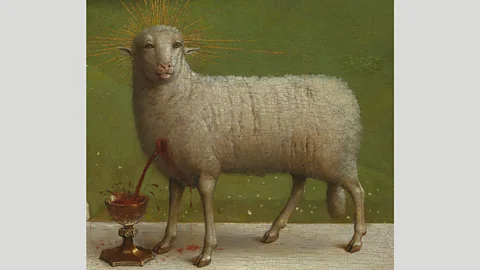 Saint-Bavo’s Cathedral Ghent
Saint-Bavo’s Cathedral GhentSixteenth-Century denizens of Ghent might have had similar thoughts, for it was then that Van Eyck’s ‘humanoid’ sheep, which appears on the lower central of the opened multi- (polyptych) altarpiece, was altered to look more sheep-like. The creature’s ears, which Van Eyck had positioned where human ears would be, were painted over and replaced by ears positioned higher up on its head. The creature’s gimlet eyes, which we now see staring back at us with an all-seeing intensity at the front of its head, were placed at the sides of its head, giving the lamb a naturally more ovine and ive appearance. (During an earlier restoration in the early 1950s, the lamb gained four ears, as some of this overpainting and varnish was removed). At the same time, the mouth and nostrils were also overpainted, leading to a visage that was far less defined than Van Eyck’s original, giving the impression, at least to contemporary eyes startled by the difference, of a comically pouty moue.
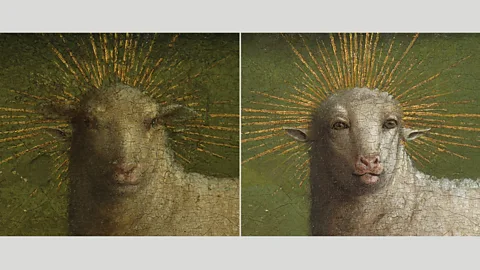 Saint-Bavo’s Cathedral Ghent
Saint-Bavo’s Cathedral GhentThe monumental altarpiece, which was finished in 1432 and resides in Ghent’s St Bavo’s Cathedral (at that time the Chapel of St John the Baptist), for which it was originally painted, is yet to undergo its third phase of restoration. This will begin in 2021 and will focus on the upper inside s. The altarpiece was traditionally opened out to reveal the spectacular vision of the enthroned deity (identified as either Christ or God the Father, more of which later) and the Lamb of God, whose holy blood spills out into a chalice, on feast days. The outside s are those that are visible when the hinged altarpiece is closed – and it’s these which have just been restored.
The 12 outer s, which are far more muted in colour than the richly pigmented imagery of the interior, describe the Annunciation. Prophets and sibyls, foretelling the coming of Christ, are situated above the two s featuring, on the viewer’s far left, the Angel Gabriel, and, on the far right , the Virgin Mary, their robes extravagantly presented in slightly stylised, angular folds. The s between them feature a view of Ghent seen through two Gothic windows and a still life – a tray, a jug and a towel – symbolic of the Virgin’s purity, while below, painted in the grey tones of a grisaille, are marble statues of John the Baptist and John the Evangelist. Framing these statues on each side are the suppliant figures of Jodocus Vijd, the merchant and the Burgermeister (master of citizens) who commissioned the piece, and his wife Lysbette, both, in their richly coloured robes, offering a vivid contrast to the muted palette.
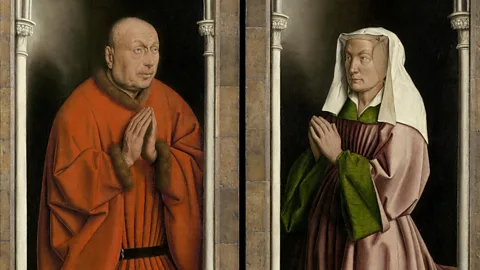 Saint-Bavo’s Cathedral Ghent
Saint-Bavo’s Cathedral GhentTemporarily separated, these newly restored outer s will form the dramatic focus of an exhibition examining the genius of Van Eyck, opening this month at the Museum of Fine Arts Ghent. It will also bring together half of Van Eyck’s extant paintings, which total around 20, alongside paintings by Northern European contemporaries and later artists responding to the altarpiece. Later this year, the altarpiece will find its way back to its new purpose-built visitor centre at St Bavo’s Cathedral amid other celebrations marking this important conservation and restoration work.
'Art firsts'
Even during his lifetime Van Eyck was venerated for his astonishing innovations, so much so that the altarpiece itself can be seen in of a series of firsts. A century after the artist’s death, at the exact time the 16th-Century overpainters, the artists Lancelot Blondeel and Jan van Scorel, were busy ‘improving’ the details of his famous altarpiece, the Florentine painter and author of The Lives of the Artists, Giorgio Vasari wrote in swooning that Van Eyck was the inventor of oil painting. This was in fact a myth that continued well into the 19th Century.
However, in an important sense, Van Eyck really is the father of oil painting. What he achieved with the medium – the extreme verisimilitude and exactitude of his execution, the fine, three-dimensional modelling, the subtle depiction of light and shadow, and the extreme realism of textures – set him apart from all predecessors. He tirelessly experimented with the medium, altering its chemical balance to achieve faster drying times, and this allowed him to build up layers of translucent paint in order to achieve all those delicate and nuanced effects.
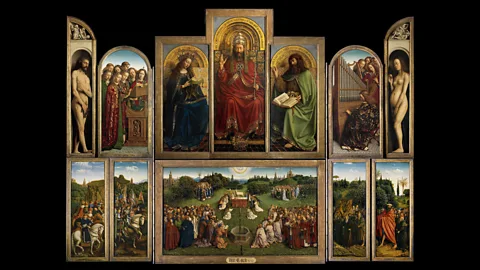 Saint-Bavo’s Cathedral Ghent
Saint-Bavo’s Cathedral GhentBefore Van Eyck, artists depicting areas of gold would typically use gold leaf, which appeared flat and decorative on the surface of the painting. But Van Eyck used pigments to depict gold and fine metal objects, with light glinting off their surfaces, just as they would appear to the observant eye. Before Leonardo da Vinci, Van Eyck really could claim to be the master of light; he was certainly known to have studied optics. What’s more, nothing like this could have been achieved with egg tempera, which was the medium of choice among artists before the Renaissance. In of achieving depth, atmospheric perspective, flesh tones and sophisticated modelling, the new medium was unsured, and so was Van Eyck’s handling of it.
Before the current project, carried out by Belgium’s Royal Institute for Cultural Heritage, 70% of the Ghent Altarpiece had been overpainted and varnished. Deep layers of varnish had yellowed over time, covering the subtleties of Van Eyck’s exquisite handiwork. In addition, there was centuries of grime, and minute flecks of paint were peeling off. What the revealed ages of the original show is that those overpainted areas almost completely flattened the modelling, for example on Jodocus Vijd’s clothes, and had removed much of the soft realisation of flesh and the highly realistic flesh tones.
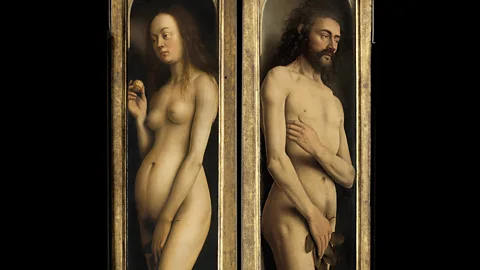 Saint-Bavo’s Cathedral Ghent
Saint-Bavo’s Cathedral GhentMeanwhile, the varnish had obscured so many intricate details, such as the marble veins of the two outer sculptures, and most of the architectural details in the background. We now even find cobwebs – what astonishing detail, which until now had been completely hidden – on the wall behind Lysbette’s head.
What’s also very striking, and has thankfully never been obscured, is the individuality of expression and emotion betrayed by the singing angels on the inner section of the altarpiece. It is in stark contrast to the idealisation of medieval art, in which all heads look the same. Moreover, the realism in the rendering of the life-sized figures of Adam and Eve also marks a new ethos in religious painting. They are (very probably) the first painted nudes to appear in an altarpiece, and are so lifelike that one can almost imagine the couple stepping out of the frame. Indeed, Adam’s toes appear to protrude over the frame, and he’s positioned as if he’s about to step out, while Eve teeters more ively on the edge. So dedicated was Van Eyck to reality over simple idealisation that this was the very first time nudes had appeared with pubic hair in art.
So when Van Eyck painted his holy lamb, the symbol of Christ, he knew that he didn’t want just an ordinary lamb. It would have to arrest the viewer as an extraordinary presence. After all, Van Eyck was a master of marrying the material world with that of the sacred (also with the frankly unnerving), and this he achieved throughout the work, including in the lusciously idealised landscape the lamb inhabits and in which botanists have identified almost every plant and flower. And here’s another first: this is the first landscape in Northern European painting, or at least the first we know of.
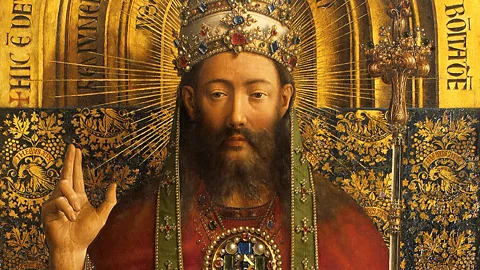 Saint-Bavo’s Cathedral Ghent
Saint-Bavo’s Cathedral GhentThe next phase of the restoration concentrates on the upper s of the inner altarpiece, and here, directly above the unnerving mystic lamb, we find the majestic deity, who is both emulating the style of a Russian icon (Van Eyck is clearly inspired by Byzantine art here) and an emperor who is rendered in flesh but who still suggests omnipotence. In fact, the French artist Jean-Auguste-Dominique Ingres based his great painting of the Emperor Napoleon on this .
But is it Christ or God the Father that Van Eyck has depicted? It is a question that’s exercised art historians, and there are those who argue that the ambiguity is deliberate. It would, in fact, be among the earliest representations of the New Testament God in painting, certainly in altarpiece painting (the painted altarpiece was relatively new in any case; they would typically have been carved). Here the figure holds an extraordinarily rendered rock crystal sceptre, the symbol of pure power, while a bejewelled crown lies at his feet. He is placed directly above the tiny sacrificial lamb, in a natural hierarchy. If it’s the son of God, we can say for certain that never before had Christ himself been depicted in such a resplendent, all-powerful manner.
Director of the Musea Brugge, Till-Holger Borchert, who sits on the scientific committee of the Van Eyck exhibition, has his own views, and it’s an explanation that adds further weight to what makes Van Eyck such a beguiling artist.
“My personal take on that is that Van Eyck is a master of ambivalence,” he tells BBC Culture. “I’ve studied his paintings for a very long time and what I find fascinating is that if you look for sureties, this is not your painter. This is an artist who offers endless opportunities of interpretation and I think the figure is almost ostentatiously ambivalent. In any case,” Borchert adds, “what could be more complicated to the human mind than the Holy Trinity in Catholic theology? Van Eyck suggests that complication in the painting.”
Who knows what the restoration of the figure will reveal. But one thing is guaranteed: this unprecedentedly ambitious and complex altarpiece will continue to surprise us for many more years.
Van Eyck: An Optical Revolution is at the Museum of Fine Art Ghent, 1 February to 30 April 2020.
If you would like to comment on this story or anything else you have seen on BBC Culture, head over to our Facebook page or message us on Twitter.
And if you liked this story, sign up for the weekly bbc.com features newsletter, called The Essential List. A handpicked selection of stories from BBC Future, Culture, Worklife and Travel, delivered to your inbox every Friday.
